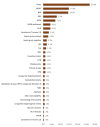The Prevalence and Associated Risk Factors for Neonatal Thrombocytopenia Among Newborns Admitted to the Neonatal Intensive Care Unit
- PMID: 38618311
- PMCID: PMC11014734
- DOI: 10.7759/cureus.56108
The Prevalence and Associated Risk Factors for Neonatal Thrombocytopenia Among Newborns Admitted to the Neonatal Intensive Care Unit
Abstract
Background Thrombocytopenia is the most prevalent hematological condition in neonates that develops in the neonatal intensive care unit (NICU). This set of illnesses is caused by either decreased platelet production due to placental insufficiency, increased platelet breakdown (consumption), or a combination of the two causes. Based on platelet count, it is defined as mild, moderate, or severe thrombocytopenia, with early and late onset. Purpose The purpose of this study is to determine the prevalence of thrombocytopenia and the factors that contribute to it in newborns hospitalized in the neonatal critical care unit at the Maternity and Children Hospital in Al Ahsa, Saudi Arabia. Methods This descriptive retrospective cross-sectional study was carried out at the NICU of the Maternity and Children Hospital in Al Ahsa, Saudi Arabia, over the span of one year (August 2022 to August 2023) among hospitalized neonates with thrombocytopenia. Thrombocytopenia is defined as a platelet count of 150,000 or less. These patients were monitored until they recovered or died. Results The inclusion criteria were met by a total of 242 newborns with thrombocytopenia. Half of the neonates (57%) were full-term, with Apgar scores greater than 5 at the first (84%) and fifth (93%) minutes, respectively. The great majority of individuals (84%) experienced early-onset thrombocytopenia of mild severity (62%) and were asymptomatic (93%). The majority of the cases resolved spontaneously, with only 21% requiring platelet transfusion. There was a significant relationship discovered between gestational age and the severity of thrombocytopenia, with very preterm infants having moderate to severe thrombocytopenia, as well as birth weight (p=0.001). Furthermore, neonates with severe thrombocytopenia had a considerably higher mortality rate (p=0.001). Conclusion The mortality and morbidity of newborns with perinatal risk for neonatal thrombocytopenia can be reduced with timely detection of the cause and development of thrombocytopenia, as well as adequate and early care.
Keywords: al ahsa; bleeding; neonatal intensive care unit; neonate; risk factor; saudi arabia; thrombocytopenia.
Copyright © 2024, Al Ghadeer et al.
Conflict of interest statement
The authors have declared that no competing interests exist.
Figures



Similar articles
-
Hypoxia as a predisposing factor for the development of early onset neonatal thrombocytopenia.J Clin Neonatol. 2012 Jul;1(3):131-4. doi: 10.4103/2249-4847.101693. J Clin Neonatol. 2012. PMID: 24027708 Free PMC article.
-
Characteristics and Associated Risk Factors of Neonatal Sepsis: A Retrospective Study From Saudi Arabia.Cureus. 2024 Dec 28;16(12):e76517. doi: 10.7759/cureus.76517. eCollection 2024 Dec. Cureus. 2024. PMID: 39872571 Free PMC article.
-
The Etiological Profile of Neonatal Thrombocytopenia in Neonates in Neonatal Intensive Care Unit: A Cross-Sectional Study.Cureus. 2023 Nov 7;15(11):e48422. doi: 10.7759/cureus.48422. eCollection 2023 Nov. Cureus. 2023. PMID: 38073987 Free PMC article.
-
Evaluation and treatment of thrombocytopenia in the neonatal intensive care unit.Acta Paediatr Suppl. 2002;91(438):74-81. doi: 10.1111/j.1651-2227.2002.tb02908.x. Acta Paediatr Suppl. 2002. PMID: 12477267 Review.
-
Thrombocytopenia in the neonate.Blood Rev. 2008 Jul;22(4):173-86. doi: 10.1016/j.blre.2008.03.004. Epub 2008 Apr 22. Blood Rev. 2008. PMID: 18433954 Review.
Cited by
-
Development and implementation of restrictive platelet transfusion thresholds in a neonatal intensive care unit.J Perinatol. 2025 Apr 21. doi: 10.1038/s41372-025-02302-4. Online ahead of print. J Perinatol. 2025. PMID: 40259097
References
LinkOut - more resources
Full Text Sources
Miscellaneous
